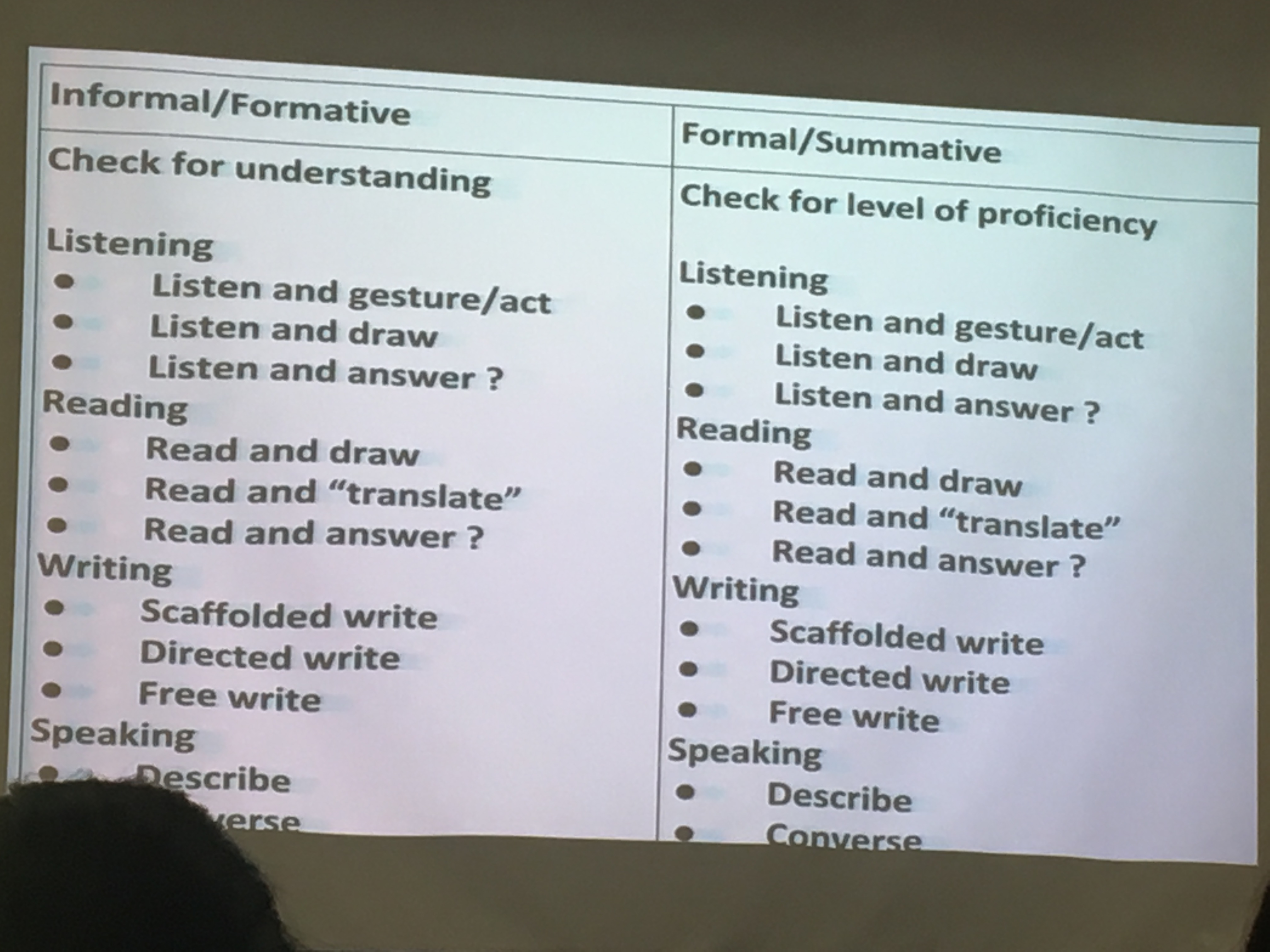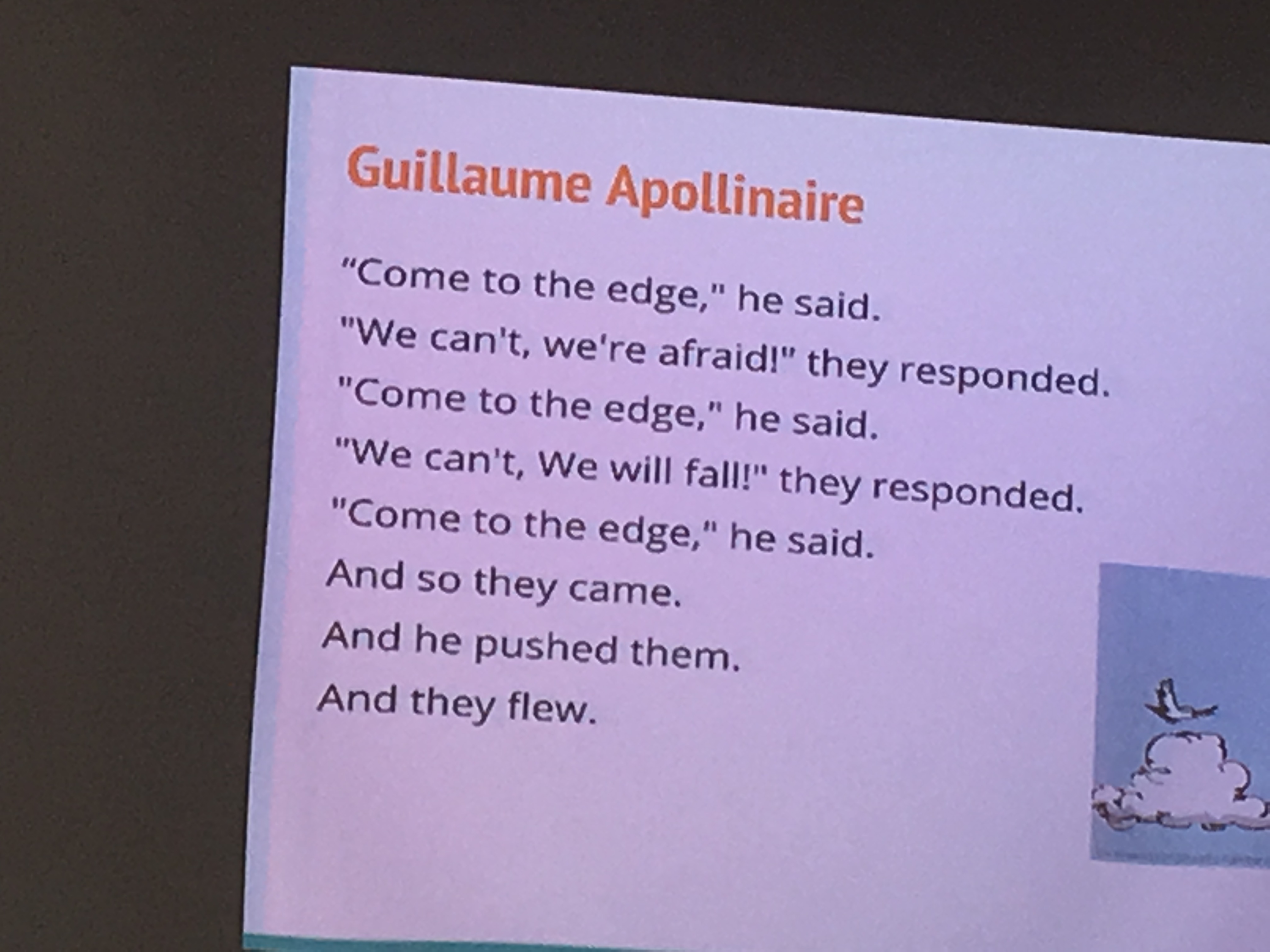
Terry Waltz, Ibu Anne, Laurie Clarcq and Anny Ewing

Spiderman, Ibu Anne, Batman and Wonderwoman
What is the difference between the two photos? Nothing! They are both photos of yours truly with superheroes!!!!
I was so excited to have the opportunity to attend a conference with three superheroes of mine – Terry Waltz, Laurie Clarcq and Anny Ewing. I was not disappointed!
Below you will find gems I discovered at the conference. I hope some of these gems will be useful for you too!
Gaining Students’ Attention
- Start singing ‘If you’re Happy and You know it’, kids will start joining in with the actions.
- Sing! Hold a note!
- 3-2-1 Waterfall. Kids all go SHHHHHH
Four Key Principles of Teaching with Comprehensible Input:
- make it comprehensible
- provide repeated exposure
- keep it interesting
- teach for success
Rules for the TCI Classroom: (These are for teacher as well as student)
0. Naked desks – nothing on desks! Better yet, go deskless!
- Listen to understand
- Answer all together (unless I am asking a specific person/I stop you)
- STOP
- 2 words
- Ooh! Aah!

Rules explained:
Why would you ask a question of a specific person? You could be asking the ‘barometer’ (one who gets it eventually but takes a bit longer to process; tries hard) to gauge comprehension OR you could be asking a fast-processing student for extension.
If you do ask the fast processor, add “Look at me and smile if you could have answered that question.”
Use a wait signal so kids can have extra processing time: honour the thinking.
When would you let kids use 2 words? When you are fishing. Kids can answer in L2 or us 2 words. When fishing, use the “fairy dust” hand gesture to indicate you are wanting an answer/idea from students.
Say “Please answer in L2 unless I need an idea”. Limit your own English!!!
Best to have classroom signs with picture, L2 and English.
Remember that repetition is repeated MEANING, not sound! ie Ensure students understand the word!!
Ooh! Aah! You can use these sounds as well as rejoinders such as Astaga! Kasihan! Aduh! Keren! Hore! If kids get carried away, you can use a conductor gesture to stop them, or tell them “Kontrol” or “Sudah” to develop self-control. Point to the sign, then gesture to ‘cut off’ the sound.
THINK FEEL SAY DO
Feelings are so important to kids. If they can attach a feeling to a word, can learn it so much better. There is a difference between ‘requested’ and ‘forced’ output. We do not want to force output. Give kids the opportunity to opt out of answering in L2 if they are not confident. You only use L1 to see what the level of comprehension is. “How would you say…?” “What did I just say?”
Rules need to be MODELLED, EXPLAINED and PRACTISED. You don’t get buy-in if kids don’t understand why they are learning with TCI.
To communicate is to put our picture in someone else’s mind or heart.
Kids can ask teacher to STOP if they don’t understand (with a gesture). Teacher will also STOP if it is clear someone doesn’t understand. Practise the gesture for “I don’t understand”. If students see someone else doing that gesture, they do it too. (Saves individual feeling stupid or embarrassed)
Another rule could be:
6. Grandma Grandma means G-rated. Kids can only give ideas that grandma would approve of. Have a cool poster of Grandma. My grandma loves interesting stories. She falls asleep with the boring stuff. Swear words make Grandma angry.
The Lesson
Grab their interest in a novel way.
Give them a reason for learning – show them the gold (what will they be able to achieve at the end) eg Terry told us “At the end of this lesson you will be able to read this Hawaiian script”.
Have your new structures written on the board so you know where you are heading, as well as posters for Who? What? Where? How? How many?
Good idea to ask a colleague to survey your lesson to find out:
- how many times do students answer in L2?
- how many questions do I ask?
Use English ONLY for two reasons:
- to ensure the picture is clear (comprehension check)
- to ‘fish’ (ask) for story details
Ask LOTS of questions. Don’t ask questions unless students have the TL (Target Language) to answer. Questioning is a super important skill.
When students are in their first 3 years of learning the language, don’t worry about correcting grammar.
Teach kids how to accept a compliment. “Amelia, I am going to tell the class something about your sentence. You can accept the compliment with a royal nod or wave like the Queen.”
Make it comprehensible!
- establish meaning
- support meaning – write on board, posters (pause and point!)
- comprehension checks
Provide Repeated Exposure:
- ask questions
- confirm answers (Brad Pitt’s house)
- extend answers (Brad Pitt’s big house in Melbourne)
- parrot/repeat in ‘conversation’

Get a kid to be the parrot and repeat funny/important bits throughout the lesson.
Choose one new structure plus any/all of what they already know. A structure is a chunk of language with meaning, preferably high frequency.
You can plan using a full story, or have a story skeleton with minimum sentences and students will fill in the details. Keep it interesting!
Excellent Eight
- mau
- suka
- di
- (pergi) ke
- punya
- ada
- beri
- ambil
Sweet Sixteen
The above, plus:
- lihat
- bisa
- berkata
- pulang
- pakai
- dengar
- datang
- tahu
Ways of Assessing

Putting it all Together – Laurie Clarcq
Learning is: Acquisition is:
- difficult easy
- conscious unconscious
- fast slow
- soon forgotten remembered
- for the ‘smart kids’ for everyone!
all about how the L2 is used is all about what is being said
Ideas for Kursi Luar Biasa (Special Chair)
- have other students ask questions of the special student
- have 2 KLB and ‘fans’ of each person. Pump up the fans and ask them about their ‘special person’. Keep their attention by seeing which fan group is being more responsive.
Student has to listen to understand. Teacher must speak in order to be understood.
The Process of Language Learning
- Hear it (nothing happens if you don’t hear)
- Recognise it (Get kids to write/draw word, then translate)
- Understand it
- Connect it (input/output)
Ask S (student): Where are you in the process?
When teaching structures, put things that are hard to acquire (eg verb to be) with things that are easy to acquire. eg “is” a teacher
Krashen’s i + 1
input that grows language = stuff already acquired or accessible + 1 new structure (high frequency)
Game to practise output
Get kids into 2 circles, inner and outer, facing each other. One person stated a structure from the story eg “Ibu Anne punya ular” and the partner had to react with a rejoinder “Astaga!” “Keren!”
Fishing
Go fishing where there are fish!
Only use circling for new information and for fishing – it is like swearing, use it appropriately!
Have a signal for ‘whole class answers”, such as hand up or arms spread wide.
Honour all the answers kids give. Ide bagus! Be positive. Practise and use a thinking face. Vote and count to choose the character/place, or pull from jar. Close eyes/cover eyes to vote.
3 fer – three reps in a row, such as Is Bob a teacher?
- Yes, Bob is a teacher. Bob is not a dentist. Bob is a teacher.
Machine gun Nos – park on the No
- Is Bob a dentist? Is Bob a doctor? Is Bob a hairdresser? Is Bob a fisherman?
Primary Teaching – Anny Ewing
Tell kids “Your job is to look, listen and understand.”
My job is to make it easy for you to understand.
Keep the rules simple (see photo above).
For comprehension checks:
Close your eyes and hold up from 1 – 5 fingers to show understanding. Five fingers is complete understanding. Have a written comprehension check – five questions Yes or No. Or have different actions for yes and no and students move to show understanding. Jump up for YES! Crouch down for NO!
Reading
Purpose-written TPRS text is:
- connected
- written by a fluent speaker (gulp!)
- written with a goal of 100% student comprehension
A parallel text can be used for assessment.
First Reading of Story
- Read as a group.
- Circle during reading.
- Recap in English at the end. eg (Is Kevin’s house big? Where is Kevin’s house?)
Reading Activities
- Group reading on powerpoint.
- Put sentences in order. (Gesture and read slowly first. Write your sentences so there is no one correct way to order them – encourage discussion eg How could you change the ending so it would make sense?)

- Put students in pairs and then get them to put sentences in order.
- With your partner, read the story in English
- Ping-Pong reading in English (or give them a choice of L2 or English)
Embedded Reading
Embedded Reading (Laurie Clarcq)

BASE READING
Base story is usually very short and simple.
This is Laurie. This is Jose. Laurie and Jose go to Las Vegas. Jose is happy.
- Show sentence by sentence with pictures.
VERSION 2
- Introduce new vocabulary.
- Play with new structures.
- Show story with pictures.
- Show text only.
VERSION 3
Wins a chicken
- Put something wacky or unexpected in the reading.
- Act it out.
VERSION 4
Add one word eg fantastic. Add the word wherever it makes sense in the reading. Ask students, “Where else could we have ‘fantastic?’ Read the story out loud to a partner. Every time you say ‘fantastic’, they make a noise/action.
Laurie started an embedded reading by using a story written by a student, with bits added from other students to build up different (more difficult) versions.
Tip: when kids are reading, get them to fold over the paper and use edge of paper for ‘dropping and dragging’. It helps to avoid them getting distracted. They can also fold it to mark their spot in the reading. You can tell kids to “Park the Car” when they have found 3 tricky bits.
Translate to: clarify, check.
Steps:
- We read together.
- We read and discuss.
- We read and wonder.
GOOD stories have: a strong character, a relevant (to students) setting, the situation (use focus language) must be interesting and visual.
Great tip for reading: One sentence of reading per year of language study.
BASE
Grandpa was at a party. He forgot to wear pants. He covered himself right away.
To extend the story, ask yourself questions such as WHEN, WHO WITH, WHAT KIND?
Yesterday/One day, grandpa was at a party with his friends.
Stop and use speed sketching. Encourage kids to “Share and enjoy” (not point and laugh). Then talk about pictures. Who is grandpa with? What are his friends doing at the party? What can you see at the party?
Made to Stick – book about stories that ‘stick’.
Wired for Story – writing great stories
Instructional Cycle

Backwards Planning
Ask yourself:
- What do I need to do with my S in order for them to be able to …?
- How can I get them to do that?
It is not about data, it is about students!
Backwards inspiration: how do I feed the students? (the baby doesn’t grow because you weigh it!!)
Think about your end goals: I want them to read novels, examine and report, summarise chapters (for example).
What do I want them to be able to do at the end of the year?
- Listen and comprehend (mini and macro goal) ____.
- Read and comprehend ____. (familiar sentence, short story, novel)
- Speak and ______. (Retell a familiar story)
- Write and _____.
If there are things you need to teach (such as weekend activities), put them into stories!
Accessible language is language the teacher gives (points, posters, on board)
Make sure your lesson fits the “lens test” – look at it through eyes of the principal.
Plan with question words.
WHO VERB PHRASE WHAT WHERE FOR WHOM/WHAT WHEN
Opening activity of lesson should always be about building community.
Closing activity: leave them (and you) feeling good – breathe, play music, turn and tell a joke, dance, heads down and relax, dead fish.

Great prose to read when you are too scared to try something new!
Laurie-isms
GTS – Google that Stuff
Voluntold -When you ‘volunteer’ but actually you are told to do something!
You are where you are supposed to be.
Round of Applause: clap around in a circle
Progress, not perfection!
Be an authentic teacher with passion.

















 To do this, use Powerpoint. Insert different shapes, then select shape fill, then picture. Ask your students to retell the story. Share a picture of the slide to their iPads, or ask them to take a photo. Then they tell the story to a face (a stuffed animal face, a picture of someone), then to a friend, then to the teacher.
To do this, use Powerpoint. Insert different shapes, then select shape fill, then picture. Ask your students to retell the story. Share a picture of the slide to their iPads, or ask them to take a photo. Then they tell the story to a face (a stuffed animal face, a picture of someone), then to a friend, then to the teacher.


















